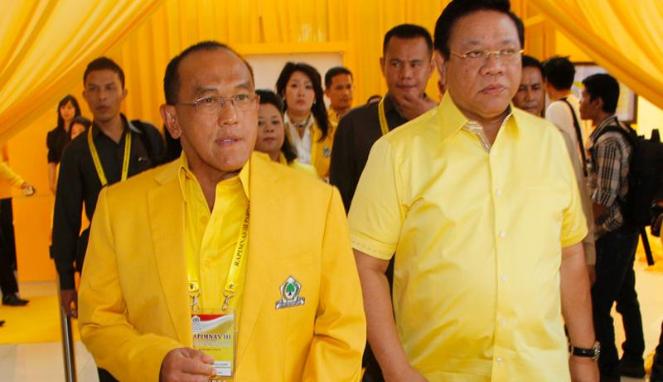In December 2014, Indonesia’s oldest and second largest political party, Golkar, started to fall apart, splitting into two rival factions.
The first is led by business tycoon turned-politician, Aburizal Bakrie – Golkar chairman since 2009. His re-election last month in Bali has been highly contested.
The second is headed by businessman and former cabinet member, Agung Laksono.
Golkar’s fragmentation began after the party’s poor showing in the 2014 parliamentary election.
The Laksono camp wants Golkar to move away from defeated presidential candidate Prabowo Subianto and his coalition, instead supporting President Joko ‘Jokowi’ Widodo and his government.
Laksono and some senior party members have already taken the extraordinary step of holding another Golkar national congress, electing Laksono as the new Golkar chairman for the next five years.
The dispute has now taken embarrassingly new highs. A week before the party’s Bali congress, which was hold on November 30 2014, a group of party cadres led by parliament member Yorrys Raweyai raided the party headquarters in Jakarta in support of Laksono. The confrontation turned violent.
Unsurprisingly, the dominant response to the Golkar conflict has to been to look at the bickering and back fighting and ask, who is the legitimate chairman?
But this question of leadership fails to identify a bigger concern for Indonesia’s democracy – a cohort of actors who use their powerful resources to weaken Indonesia’s independent party system through total domination.
The Golkar conflict reveals how oligarchy has come to work through political parties.
In modern democracies, the party is an important organisational pillar for channeling people’s political aspirations to take part in forming and influencing government.
Theoretically, the party is inclusive, open to all citizens who have the same opportunity to compete for entry into the party’s structure. In reality, parties are vulnerable to ‘capture’ by certain figures and groups to express and defend their exclusive interests, as has occurred in Indonesia.
Since the downfall of President Suharto’s authoritarian regime in 1998, political parties have been slow in adapting to Indonesia’s new political system. One weakness is the strong grip on the party system by a few powerful people.
These people use their material power to dominate the party structure and block any strong democratic challenges from the grassroots.
Oligarchy represents a major threat to the party system in any democracy. In his book Oligarchy, Jeffrey Winters argues that oligarchs are “material based individuals who exert their minority power to defend their wealth from threats.” In contrast to other scholars who emphasize the economic factor that can determine the social and political outcomes, Jeffrey Winters argues that oligarchy is part of a politics of wealth defense, in which oligarchs can block threats from the state, other oligarchs, the grassroots, or combination all of which. Additionally, Winters says “These materially concentrated people use minority power politically to defend their wealth with important economic effects,” regardless of any type of governments. The oligarchs can use all means, such as a personal protection, a coercive instrument, rule of law, and a collective agreement to defend their wealth.
Along similar lines, Stanislav Markus suggests that there are two kinds of oligarchy: state capture and business capture. The former refers to elites or state officers who draw material resources by exploiting government positions and political institutions to become oligarchs. In this regard, these oligarchs attain a huge amount of material resources by misusing their positions as officials of the state.
By contrast, in business capture, oligarchs use government positions and political institutions. The super-wealthy attain material resources from their own businesses and use the state institutions to protect their economic interests. Additionally, Markus explains that these two types of oligarchs result from weak rule of law within a democratic system.
The Golkar case is evidence of Markus’ idea of business capture. All top official party members have one thing in common: they are figures with concentrated material power. This includes the current chairs Bakrie and Laksono; former cabinet member Theo L Sambuaga; current parliament member Priyo Budi Santoso; and a business tycoon, Setya Novanto. Golkar is dominated by wealthy elites who also control the channels for emerging leadership and party cadres.
What has been interesting to witness over the period of Indonesia’s democratisation is Golkar’s transformation from a party with a single patron, Suharto, to a number of oligarchs competing for power.
Suharto used the party as the main political vehicle to win every single election from 1971 to 1997. Winters argues that after the fall of the New Order, Suharto-backed oligarchs resurrected the party in the face of calls to disband it as a means of self- preservation in the new democratic system.
During the national congress in Bali in 2004, oligarchs such as Jusuf Kalla, Agung Laksono, and Aburizal Bakrie took over the major positions in the party – ousting, Akbar Tandjung, a former chairman and leading candidate who could not stump the funds to ‘secure’ support from regional party executives.
Once in place, oligarchs like Bakrie and Kalla used the party to protect their material resources and expand their interests in government.
These wealthy people exert their material power to simultaneously develop other powerbases across official positions (including the president, cabinet ministers, and other state officials) and formal political positions (such as chair of a political party). For instance, Kalla has been a minister in many regimes and also vice-president during SBY’s first term (2004-2009). He is now serving as Jokowi’s vice-president. Likewise, Bakrie was a minister from 2004 to 2009.
In this regard, economic power can generate and degenerate other power sources.
When he was a coordinating minister for economic affairs, Bakrie had a dispute with a former minister of finance, Sri Mulyani, regarding tax arrears. Mulyani pushed Bakrie’s troubled companies to pay all their arrears. Many believe that Bakrie made a deal with former president SBY to expel Mulyani from the cabinet and recommend her to become a managing director at the World Bank. SBY had to deal with Bakrie, because he had to secure support from Golkar, which was a strategic partner under SBY’s coalition government.
Bakrie knew how to use his party position to defend his business interests at the expense of social interest. Even as president SBY was incapable of backing Mulyani, instead forced into compromise with an oligarch.
Unlike the personal and dynastic parties, such as the Indonesian Democratic Party of Struggle (PDIP) led by Sukarno’s bloodline, the Great Indonesia Movement Party (Gerindra) led by Prabowo Subianto, and the Democrat Party led by SBY’s family, Golkar was formed over years through a strong network embedded all the way down to the village level by loyalist cadres.
Additionally, Golkar’s young cadres can move vertically without necessarily needing a relationship with top official party families; but only to a point. Cadres have very limited chance of contesting national positions because they lack the material resources to challenge the oligarchs who can spend as much money as they want in order to obtain loyalty from regional representatives.
Golkar continues to wield enormous clout on the Indonesian political landscape. In 2014, the party garnered the second most votes after PDIP and previous governments have needed the party’s support to push through policies. This year, for the first time in Golkar’s political history, the party finds itself outside of government. However, the party maintains enough leverage to reconfigure the current political arrangement.One of two camps–Jokowi’s camp and that of the defeated presidential candidate Prabowo’s Subiato–will enjoy high political support, in both the executive and legislative branches, if Golkar sides with it.
Golkar’s status as the second largest party in the country is highly attractive to the forces of oligarchy who see the party as an important means by which they can maintain their existence and defend their political and economic interests.
Given that the conflict remains unsettled, the government is still in the difficult position of choosing which faction to officially recognise. The current decision by the Minister of Justice and Human Rights, Yasonna Laoly, not to interfere in Golkar’s internal rift is laudable. The government has taken a neutral stance – encouraging internal party means to resolve the problem.
Indeed, the best option lies in recognising all Golkar cadres, because they have rights and opportunities to bring together all disputing factions and find the best solution to the conflict.
The Golkar internal rift is not about how to destroy other oligarchs; it is another example of how control of political instruments is used to secure their political and economic interests.
Hipolitus Yolisandry Ringgi Wangge is an Arryman scholar and a visiting scholar at the Buffet Center for International and Comparative Studies (BCICS), Northwestern University in Evanston, Illinois. He can be reached at wanggeyolis@gmail.com
 Facebook
Facebook  Twitter
Twitter  Soundcloud
Soundcloud  Youtube
Youtube  Rss
Rss 
